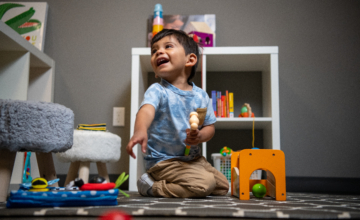When they have tantrums and “act up,” they’re often showing you they are overwhelmed by their feelings and need support. To develop self-control, young children need limits they can understand. This takes time and is something they learn gradually. In fact, many adults still struggle with self-control!
Limits help children feel safe when they are out of control. Children test limits because they want to know that the limit is solid. They also want to see what will happen next, or what your reaction might be. Imagine a child walking along a fence, testing every part of the fence to see if they can break through. If the fence is strong and reliable, there will be less limit-testing as time goes on.
The power of prevention: Heading off misbehavior
- Decide if setting a limit is necessary. It’s good to know how and when to avoid power struggles. Get clear on what is important and where you can be flexible. For example, you might decide that hitting is an absolute “no.” But can you live with an outfit that doesn’t match if your child wants to choose their own shirt?
- Be consistent. Set up a few clear and age-appropriate rules. This helps your child understand what you expect. Follow through on the rule every time. If your child throws a toy, put it away, every time, right away. Then they learn not to throw toys. One way to remember this is: If you’re going to say yes, say yes right away. If it’s no, then it’s no all day.
- Offer tools to help them wait. Set a kitchen timer if you need five minutes to fold some clothes. This may help your child feel more relaxed as they wait. Ask an older toddler to do a puzzle, color, or look at books to occupy some time.
- Help with daily transitions. It is common for young children to have a hard time stopping one activity and moving on to the next. If your child has a hard time with transitions, give them a heads-up five minutes before it’s time to change activities. Then remind them two minutes before, and then one minute before. A routine can also help when going from one activity to the next. Read a favorite book to ease the transition between lunch and a nap.
- Offer choices to give your child a sense of control that’s reasonable for their age. Ask, “Do you want the blue or red cup?” Avoid asking questions when no choice is being offered. Say “It’s time to get in the bath” instead of “Do you want to get in the bath?”
- Look for ways to help your child practice self-control. Turn-taking games help children learn to wait. Take turns mixing the cake batter. Play Red Light/Green Light.
- Show you understand their feelings while holding the limit. Your child’s feelings are not right or wrong. It is how feelings get expressed that can be a problem. Make space for feelings (“I see that you are upset.”) while putting limits on behavior (“I will stop you from hitting.”). This can be done calmly and without shame.
Setting limits is all about your own self-regulation.
- Stay calm and present in the face of a tantrum. When your child is having a hard time, they need you to be calm. If you have a big reaction (getting angry, yelling), your child is likely to get even more upset. If you are calm, they are more likely to pay attention to what you are saying.
- Set your limit with as little emotion (and as few words) as possible. Talk in a quiet, steady voice. Be aware of the messages you’re sending with your face and body. A kind tone of voice can help calm your child. It’s also a way to soothe yourself during stressful times.
- Use simple language. It’s difficult for young children to hear what you are saying when emotions are running high. Keep your instructions clear and only give the reason for the limit once. Too much talking can complicate things.
- Take a time-out yourself if you need it. If you are too angry to respond to your child, make sure they are in a safe place and walk away for a few minutes. Let your child know (calmly): “I am feeling angry and I’m going to take a short break to help me do some good thinking.” It will help you calm down before dealing with your child and show your child what self-regulation looks like.
All toddlers try to push the limits. This new independence is an important part of their development. They develop the ability to self-regulate gradually over the next few years. Your firm, kind limits help make this happen. You might not see results right away, but stick with it and you will!





